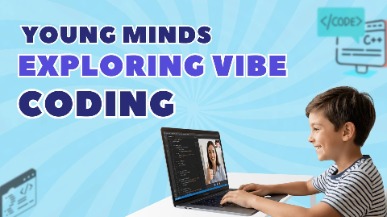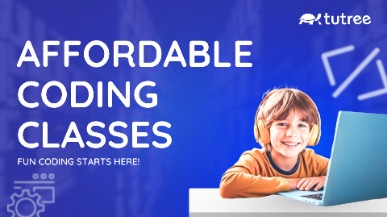Vibe Coding vs. Standard Coding Lessons: What Makes It Better for Kids?
- 8 December 2025
- Published by tutree
- STEM.org Accredited™ Partner

As a parent, you want to give your child the best tools for the future, and increasingly, that includes learning to code. The demand for coding for kids has exploded, bringing a wide range of teaching styles with it. How do you know which approach is right for your child?
Two broad methods have emerged: traditional, standard coding lessons and a newer, more engaging approach called "Vibe Coding." Understanding the difference between them is key to helping your child succeed and, more importantly, enjoy the learning process. This guide will provide a clear comparison to help you decide which path best fits your child's personality and learning style.
What Standard Coding Lessons Typically Look Like
Traditional coding lessons often remind parents of how they learned subjects in school. This approach is typically syntax-driven, focusing heavily on the rules and structure of a programming language. The learning materials might include textbooks, pre-recorded video lectures, and drills designed to reinforce specific concepts.
In these settings, students often complete worksheets or rote practice exercises. The format is usually a large group class or a self-paced online course with little direct interaction.
While this method has its merits, such as providing a solid foundation in computer science fundamentals, it also has drawbacks. The rigid structure can feel boring or uninspiring for many kids, especially younger learners. The lack of creativity and real-time feedback can cause them to lose interest before they grasp the exciting possibilities of coding.
What Is Vibe Coding? A Modern, Kid-Friendly Approach
Vibe Coding flips the traditional model on its head. Instead of focusing on syntax and memorization, it prioritizes creativity, problem-solving, and fun. This modern method is designed to feel less like a class and more like a creative workshop.
The core of Vibe Coding is project-based learning. Kids learn to code by building things they care about, such as their own video games, interactive stories, or simple apps. The learning is interactive and happens in real-time, often in one-on-one sessions or small groups.
A key feature of this approach is the emphasis on logical thinking and resilience. When a project doesn't work, students are encouraged to debug their code and figure out what went wrong, building critical problem-solving skills. Tutors, who are often high-performing high school or college students, act as mentors, making the learning environment less intimidating and more relatable. This peer-to-peer connection helps children feel comfortable asking questions and experimenting without fear of failure.
Key Benefits of Vibe Coding Over Standard Lessons
For many children, especially those new to programming, Vibe Coding offers significant advantages that foster a genuine love for learning.
-
Higher Engagement: Kids are far more motivated when they’re creating something they can see and interact with. Building a game is more exciting than completing a worksheet, which keeps them engaged and eager to learn more.
-
Better Retention: Learning through practical application helps concepts stick. When a child uses a piece of code to make a character jump, they understand its purpose in a way that rote memorization can't replicate.
-
Builds Crucial Soft Skills: Vibe Coding isn't just about programming. It teaches logical thinking, creativity, persistence, and resilience. Kids learn how to break down complex problems and work through challenges, skills that are valuable in any field.
-
Personalized Learning: Because classes are small and interactive, the curriculum can be adapted to each child’s pace and interests. If a child is passionate about art, they can work on a project that incorporates animation. This flexibility ensures every child gets the support they need.
-
Encourages Confidence: Learning from a peer tutor who is closer in age makes the experience less stressful. This comfortable environment empowers kids to take risks, ask questions, and build confidence in their abilities.
When Standard Lessons Might Still Be a Good Fit
While Vibe Coding is a powerful approach, traditional lessons still have their place. A more structured, standard method may be appropriate in certain situations.
For older students who are serious about pursuing a formal computer science education, a systematic curriculum can provide the rigorous foundation they need. This is especially true for those preparing for exams like the AP Computer Science test.
Additionally, some students thrive in a structured environment and prefer self-study with clear, disciplined exercises. If your child is highly self-motivated and enjoys a textbook-style approach, standard lessons could be a good match.
Why Tutree’s Implementation Makes Vibe Coding Effective
At Tutree, we’ve built our online coding classes around the principles of Vibe Coding to make learning as effective and enjoyable as possible. We offer live one-on-one and small-group classes via Zoom, connecting students with tutors who are close in age and passionate about coding.
Our personalized learning plans are tailored to each child’s unique pace and style. We provide parents with regular progress tracking, so you can see your child’s skills grow over time. The flexibility of our online model means classes can fit into any schedule, and our affordability makes high-quality tutoring accessible.
While our approach is fun and creative, it’s also grounded in solid educational standards. Tutree’s curriculum is aligned with U.S. grade standards and is adaptable for learners from K–12, ensuring your child is building a strong foundation while they create and explore.
How to Choose What’s Right for Your Child
Deciding between Vibe Coding and standard lessons comes down to understanding your child’s unique needs. Ask yourself these questions:
-
Does my child light up when they get to create, build, and experiment?
-
Do they struggle with rote memorization or get bored with repetitive drills?
-
Is my child a self-motivated learner, or do they thrive with guidance and interaction?
-
What is their ideal learning environment: a creative, project-based workshop or a structured, systematic class?
Your answers will point you toward the approach that will help your child not only learn to code but also develop a lasting passion for it.
Find the Perfect Vibe for Your Young Coder
For many kids, especially younger learners and those with a creative spark, Vibe Coding is the clear winner. It transforms learning from a chore into an exciting adventure, building essential skills and confidence along the way. By focusing on what makes coding for kids fun, it opens up a world of possibilities.
If you think the Vibe Coding approach is right for your child, the best way to know for sure is to try it.
Explore Tutree’s live Vibe Coding classes today and see how coding can become fun, engaging, and effective for your child. Visit Tutree to book a free trial class.


